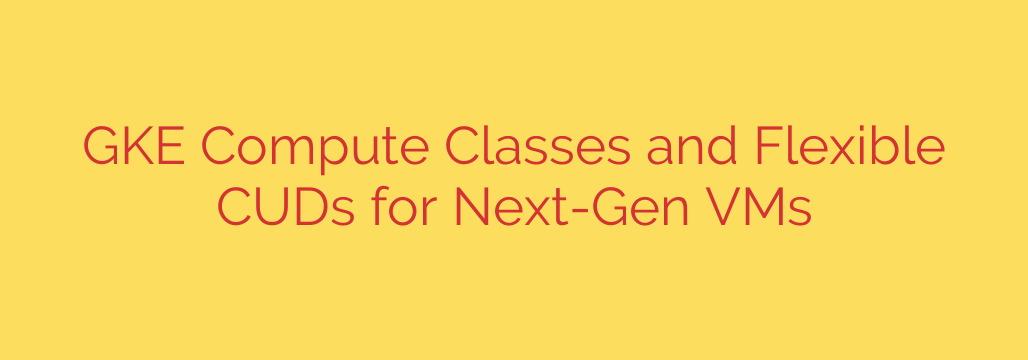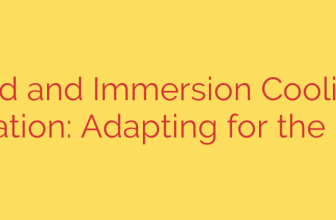
Unlock Peak Performance and Savings in GKE: A Guide to Compute Classes and Flexible CUDs
Managing workloads in Google Kubernetes Engine (GKE) often involves a delicate balancing act between performance and cost. For demanding applications like high-performance computing (HPC), AI/ML training, or large-scale web services, simply requesting generic CPU and memory isn’t enough. You need access to specific hardware capabilities to achieve optimal results. At the same time, you need a cost-management strategy that doesn’t lock you into outdated technology.
Fortunately, powerful new GKE features are here to solve this exact problem. By combining GKE Compute Classes with Flexible Committed Use Discounts (CUDs), you can now align your workloads with next-generation hardware while maximizing your cloud savings. Let’s explore how these tools work together to create a more efficient and cost-effective cloud-native environment.
What Are GKE Compute Classes?
In the past, scheduling a pod in GKE meant asking for a certain amount of vCPU and memory. Kubernetes would find a node with available capacity, but you had little direct control over the underlying hardware features. This could lead to performance-sensitive applications landing on general-purpose machines, creating bottlenecks.
GKE Compute Classes are a new resource management feature that allows you to request specific hardware capabilities for your pods. Instead of just asking for “4 vCPUs,” you can now request a class of machine that is optimized for your workload’s needs.
This is a fundamental shift that moves beyond generic resource requests and toward workload-aware infrastructure scheduling. For example, you can now explicitly request a compute class designed for:
- High-Performance Computing (HPC): Tightly coupled workloads that require low latency and high network bandwidth.
- AI/ML Training: Workloads that benefit from advanced CPU instruction sets for matrix multiplication.
- Web-Scale Applications: Applications that need high-throughput networking and efficient data processing.
By defining these requirements directly in your pod specification, you ensure that your most critical applications are always scheduled on the hardware best suited to run them.
Powering Your Workloads: A Look at Next-Gen VMs
Compute Classes are particularly powerful when paired with Google Cloud’s latest generation of virtual machines. These machines offer significant performance improvements tailored for specific use cases.
- C3 VMs: Powered by 4th Gen Intel Xeon Scalable processors (Sapphire Rapids) and DDR5 memory, C3 machines are ideal for compute-intensive workloads. They feature the Intel Advanced Matrix Extensions (AMX), which can dramatically accelerate AI/ML training and inference tasks.
- C3D VMs: Built on the same powerful C3 foundation, C3D machines add local NVMe SSD storage. This makes them perfect for applications that require high-speed access to data, such as databases or data-heavy analytics workloads.
- H3 VMs: Specifically designed for HPC, H3 VMs offer up to 200 Gbps of low-latency network throughput using Google’s Virtual NIC (gVNIC). This is essential for large-scale scientific and engineering simulations where nodes must communicate rapidly.
Using Compute Classes, you can now directly target these advanced machine types, ensuring your pods land on nodes equipped with features like Intel AMX or high-speed gVNIC networking.
Optimize Your Cloud Spend with Flexible Committed Use Discounts (CUDs)
Committing to infrastructure for one or three years is a proven way to reduce cloud costs. However, traditional CUDs required you to commit to a specific machine family (e.g., N2 or E2). This created a problem: what if a new, better, and more cost-effective machine family—like C3—was released? You were stuck with your old commitment.
Flexible Committed Use Discounts (CUDs) completely change the game by decoupling your commitment from a specific machine series.
Instead of committing to a certain number of C2 vCPUs, you now commit to a total dollar amount of vCPU and memory resources within a specific region. This commitment is then automatically applied to your usage across a wide range of eligible VM families, including C3, N2, N2D, and more.
The key benefit is freedom. You can confidently purchase a three-year Flexible CUD to maximize savings, knowing that you can modernize your GKE clusters and adopt newer, more powerful VMs like the C3 series at any time without invalidating your discount. Your commitment simply applies to the new resources you’re using.
A Strategic Approach to GKE Performance and Cost
By combining these features, you can implement a highly effective optimization strategy for your GKE environment.
- Analyze Your Workloads: Identify which of your applications are performance-sensitive. Do they require high network throughput, accelerated AI/ML processing, or fast local storage?
- Leverage Compute Classes: For your most demanding workloads, use GKE Compute Classes to request the specific hardware features they need. This ensures they are scheduled on powerful next-gen VMs like C3, C3D, or H3.
- Commit with Confidence: Purchase Flexible CUDs to secure significant discounts on your overall compute spend. This gives you the financial benefit of a long-term commitment without the technical limitation of being tied to a single machine family.
- Modernize and Save: As you migrate your workloads to take advantage of newer VMs, your Flexible CUDs will seamlessly apply to the new resources, ensuring you are always running on the most efficient infrastructure without sacrificing your savings.
By taking this strategic approach, you are no longer forced to choose between performance and cost. You can achieve both, building a GKE platform that is powerful, efficient, and economically sound.
Source: https://cloud.google.com/blog/products/compute/adopt-new-vm-series-with-gke-compute-classes-flexible-cuds/








